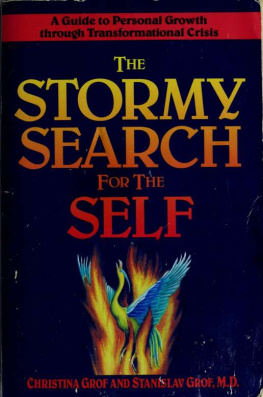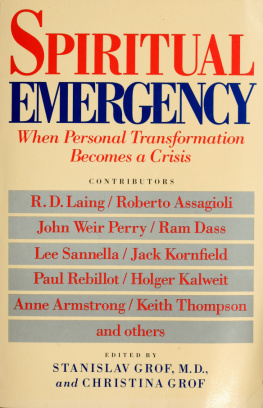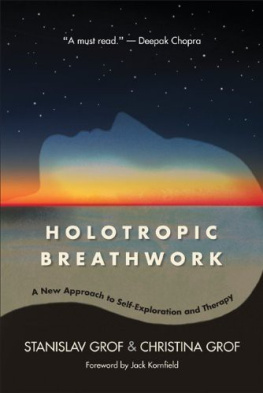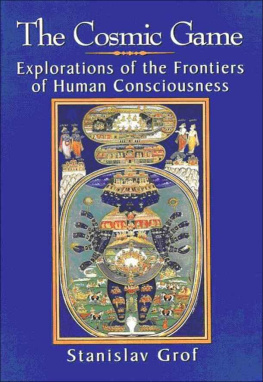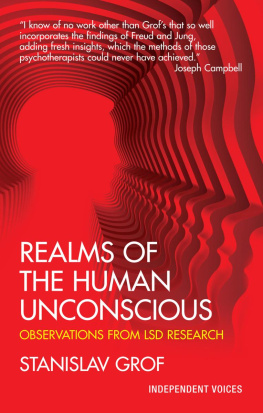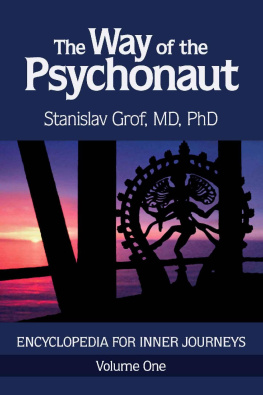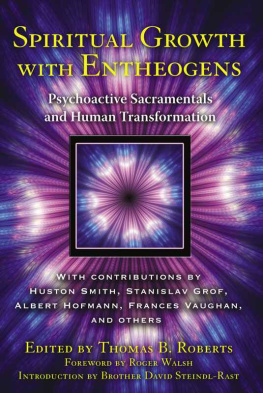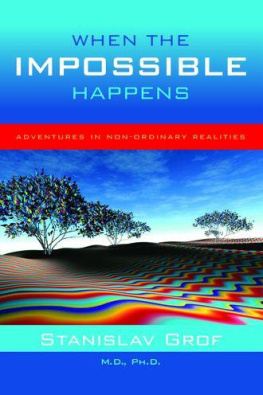This book made available by the Internet Archive.
Appendix I: The Spiritual Emergence Network 238
Appendix II: A Vision for a Twenty-Four-Hour
Care Center 242
Appendix III: Spiritual Emergency and Mental-Health
Professionals 247
Bibliography 265
ACKNOWLEDGMENTS
As we have taken the personal and professional steps that have resulted in the writing of this book, we have been deeply affected by some very special and significant people. We would like to offer our gratitude to them for all they have given us.
First of all, thank you to our families for loving and supporting us during our many detours and diversions, and especially to our beloved children, Nathaniel and Sarah Healy, who play such essential roles in our lives and constantly bring us new hope, outrageous humor, and great happiness.
We have had the good fortune to encounter a number of teachers and other sources of inspiration who have offered us friendship and direction: our deep gratitude goes to the late Swami Muktananda Para-mahansa, former head of the Siddha Yoga lineage, for his far-reaching influence in our lives; to the late Joseph Campbell, our beloved friend, matchmaker, and guide; to John Perry and Julian Silverman, for their pioneering work and their encouragement as we confronted some of the social and professional barriers that they know all too well; to Anne and Jim Armstrong, Angeles Arrien, Sandra and Michael Harner, Dora Kalff, Jack and Liana Kornfield, Father Thomas Matus, Brother David Steindl-Rast, Frances Vaughan, and Roger Walsh, our colleagues and dear friends in the transpersonal world, who through their personal explorations, teaching, and ways of being have helped to show us our own possibilities.
Thank you to the many gifted people who are involved in Holotropic Breathwork for their continuing enthusiasm and for the courage to undertake their own personal transformation and to Jacquelyn Small and Gregory Zelonka for their support of our work.
We offer our appreciation and respect to Jeremy Tarcher for gently nudging us until we wrote this book, and our sincere thanks to our editor, Dan Joy.
Our deep gratitude goes to Rod Allison, Sam Freeman, Betty Mon-aghan, Noelle Nichols, Mickey Reny, Nette Whitmore, and the other members of the loving staff at the former Brightside chemical-dependency treatment center in Carmel, California. We were enveloped by their patience, compassion, understanding, and humor during our darkest hour,
as they helped us to transform our crisis into a miraculous opportunity for healing and expansion.
A special thank you to Margaret Stevens for her honest, willing, and sensitive assistance during the formulation of this project. Our gratitude goes to the staff and volunteers of the Spiritual Emergence Network, and especially to those who have served as its coordinators: Rita Rohen, Charles Lonsdale, Megan Nolan, Nicola Kester, and Jeneane Prevatt. Their valuable contributions and personal commitment, in spite of many hurdles, have provided countless numbers of people with much-needed help. And finally, thank you to the many individuals who, over the years, have told us very personal stories of their involvement with spiritual emergencies. Without them, we would not have written this book.
AUTHORS' NOTE
We dedicate this book with love and respect to the memory of Richard Price, the cofounder of the Esalen Institute in Big Sur, California, a gentle, compassionate Gestalt practitioner and teacher, a caring husband and father, and a remarkable human being. During our early interest in the area of spiritual emergency, Dick offered us his vital enthusiasm, invaluable support, clear vision, and loyal friendship as we pursued what seemed at times a lonely and sometimes unpopular path.
Dick knew the vicissitudes of the spiritual journey from his own experience, having personally lived through two transformative crises. During the first, which occurred when he was a young man, he was hospitalized for many months and received heavy tranquilizing medication, electroshock therapy, and over sixty-seven insulin coma treatments. The second episode occurred a number of years later and was handled very differently by people who had some understanding of the process and were willing to support him.
For many years, Dick was dedicated to the idea that experiences such as his are in reality opportunities for growth, healing, and expansion. He had seen and felt the violent intrusions that often accompany professional interventions, and worked to provide alternatives to traditional modes of treatment until his tragic death during a hiking accident in 1985. His commitment to these ideas was an inspiration to us, and his support during the creation of the Spiritual Emergence Network was essential to its existence. In writing this volume, we hope to provide useful ideas, information, and suggestions that will assist in the realization of some of the dreams that we shared with our dear friend Dick Price.
Christina and Stanislav Grof
Mill Valley, California
February 1990
INTRODUCTION
Spiritual development is an innate evolutionary capacity of all human beings. It is a movement toward wholeness, the discovery of one's true potential. And it is as common and as natural as birth, physical growth, and deathan integral part of our existence. For centuries, entire cultures have treated inner transformation as a necessary and desirable aspect of life. Many societies have developed sophisticated rituals and meditative practices as ways to invite and encourage spiritual growth. Humanity has stored the treasure of the emotions, visions, and insights involved in the process of awakening in paintings, poetry, novels, and music, and in descriptions provided by mystics and prophets. Some of the most beautiful and valued contributions to the world of art and architecture celebrate the mystical realms.
For some individuals, however, the transformational journey of spiritual development becomes a "spiritual emergency," a crisis in which the changes within are so rapid and the inner states so demanding that, temporarily, these people may find it difficult to operate fully in everyday reality. In our time, these individuals are rarely treated as if they are on the edge of inner growth. Rather, they are almost always viewed through the lens of disease and treated with technologies that obscure the potential benefits these experiences can offer.
In a supportive environment, and with proper understanding, these difficult states of mind can be extremely beneficial, often leading to physical and emotional healing, profound insights, creative activity, and permanent personality changes for the better. When we coined the term spiritual emergency, we sought to emphasize both the danger and opportunity inherent in such states. The phrase is, of course, a play on words, referring both to the crisis, or "emergency," that can accompany transformation, and to the idea of "emergence," suggesting the tremendous opportunity such experiences may offer for personal growth and the development of new levels of awareness.

